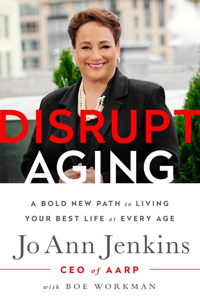AARP Hearing Center
Adapted from Disrupt Aging: A Bold New Path to Living Your Best Life at Every Age by Jo Ann Jenkins, published by PublicAffairs, a member of the Perseus Books Group (2016).


Disrupt Aging


Learn more about AARP CEO Jo Ann Jenkins, the #Disrupt Aging movement and the book Disrupt Aging. All of AARP's royalties from the Disrupt Aging book sales support the charitable work of AARP Foundation. Author Jo Ann Jenkins receives no payment or profit from Disrupt Aging book sales.
See Also:
Living in a community with services nearby and having a home that accommodates your needs are tremendous assets for those of us who want to age in place, but they're only part of the solution. Having a grocery store, a favorite restaurant, pharmacy, doctor or cleaners only a half-mile away doesn't mean much if you can't get there. Having options to maintain mobility, to get around and do things, is essential.
My mother-in-law lives independently in Washington, D.C. She is very fortunate that she is in such good health. Just about every day she walks outside of her apartment building and takes the bus to the metro station where, she boards a train to whatever shopping area or mall she has decided to go to for the day. She does her walking inside the mall, has lunch, and she's back home around 3 p.m. She's incredibly lucky to have her health and a strong, clear mind.
My father, however, is 87. He lives in rural Alabama about 16 miles outside of Mobile. We are trying to convince him stop driving. But driving is a form of independence for him; it's part of his identity. Some days he drives to Mobile to visit family or friends. Some days he runs errands. I know this independence is what keeps him happy, motivated, and alive. I don't know how he would get around if he did — there is no public transportation within 10 miles of where he lives.
We are a nation that loves our automobiles. Want a quart of milk? Get in the car. Going to school? Get in the car. Going to church? Get in the car. Going to the doctor? Get in the car. Remember GM's slogan of a few years ago: "It's not just your car — it's your freedom"?
That's the way many people still feel about their cars, but the fact is that as we get older, we tend to drive less or, in some cases, not at all. Our increased longevity means that millions of baby boomers face the prospect of outliving by a decade or more their ability to drive. If we don't drive, or if we drive on a more limited basis, how do we get to the doctor, our houses of worship, to the grocery store, to restaurants, to visit family and friends? Sadly, in many cases we don't.
In fact, over half of all nondrivers stay at home on any given day because they don't have transportation. And 60 percent of seniors report that there is no public transportation within a 10-minute walk from their home. Many live in areas without sidewalks, especially those who live in suburbs and rural areas. They are more likely to be injured by a vehicle when walking than younger people are. This is a problem that goes well beyond just not being able to get around. By sitting at home, often alone, we risk becoming isolated and sedentary, which can have devastating effects on our physical and emotional health. I'm not just talking about inconvenience — that's bad enough. I'm talking about the loss of belonging and the feeling of being marginalized, both leading to physical and mental deterioration.
This is the unfortunate result of communities that aren't planned with older people in mind. Inevitably the built-in barriers to mobility — and thus livability — cause people to become isolated, contribute to sedentary lifestyles, and, ultimately force them to make changes they don't want to make.
Even in cities where more public transportation options exist, the buses and trains are organized largely around commuting patterns. Often there are plenty of stops around office parks and commercial areas, and service is frequent during the morning and afternoon rush hours. But if you want to go to the community center around 11 in the morning or you want to meet a friend for lunch, public transportation may leave you stranded or take far too long to be practical.
When we think about creating livable communities that help people thrive and stay engaged as they get older, public transportation and safe streets should not be an afterthought or a last resort for people who no longer drive. Public transit and safe streets should be the norm so people of all ages and abilities will be able to use them throughout their lives.
Read Another Excerpt
- Disrupt Aging by Rethinking How We Live
- The 'Disrupt Aging' Where We Live Checklist
- Disrupt Aging with 'Green House' Nursing Care
Page published April 2016


























































